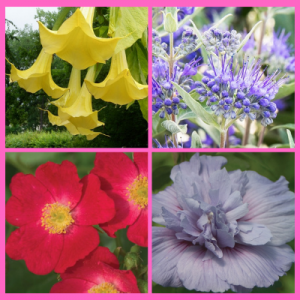by Ken Lain, the mountain gardener
If your landscaping seems to look bedraggled, it’s time to look into growing some summer-flowering shrubs. Some of these bushes begin blooming earlier in the year but have good staying power, continuing to blossom well into September, some even later. Some just are late bloomers. Either way, they’re critical allies if your landscape is crying out for a continuous sequence of summer blooms.

Blue Chiffon Rose of Sharon – Candy Oh! Rose
Angel’s Trumpet is one of the more spectacular, and interesting, option to a garden’s summer blooms. One year we grew an Angel’s Trumpet in the compost pile, and the third week of August were rewarded with 175 large, trumpet-shaped blooms, all at the same time! Because an angel’s trumpet is not cold-hardy enough for mountain gardens, it needs to overwinter indoors. (We are fortunate to have plant-loving family members in Mesa who watch our tropical flowers through winter, then bring them back to Prescott in May after the frosts.)
Bluebeard Shrub adds the spice that furnishes a different aspect in your landscaping. Unlike the other bushes on this list, the fluffy flowers give the plant a soft appearance. The blue blooms of this shrub are beloved by all pollinators, especially our local bumblebee population.
Blue Chiffon Rose of Sharon has the pizzazz that WOWs summer gardens with its prolific powder blue flowers. Not as strong a blue as the Bluebeard Shrub’s, but the hundreds of soft blue, hibiscus-like double blossoms are sure to impress even the most stoic gardeners.
Candy Oh! Rose is part of the Easy Elegance line of shrub roses that begin blooming in spring, then flower non-stop right through summer. Candy Oh! is one shrub our gardens can count on for fabulous red flowers in June, July, August, September, even into October.
 Crape Myrtle is hardy enough to survive our local winters, but its growth seems stunted in comparison to the way it grows in the Southeast and Texas. In my personal gardens, this bright bloomer acts more like a perennial; a fresh new shrub emerges after winter from the roots and blooms throughout the later summer and early fall season. No other plant in the mountain landscape has fluorescent flowers like a crape myrtle. Because it never grows into tree size, it is much lower maintenance than in other parts of the country.
Crape Myrtle is hardy enough to survive our local winters, but its growth seems stunted in comparison to the way it grows in the Southeast and Texas. In my personal gardens, this bright bloomer acts more like a perennial; a fresh new shrub emerges after winter from the roots and blooms throughout the later summer and early fall season. No other plant in the mountain landscape has fluorescent flowers like a crape myrtle. Because it never grows into tree size, it is much lower maintenance than in other parts of the country.
“Dinner-Plate” Hibiscus, or Hibiscus moscheutos, is a perennial form of tropical hibiscus that winters over like other perennial flowers in a mountain garden. This hip-high bush is known for its enormous flowers, hence, its “Dinner Plate” nickname. Its impressive red flowers grow to the size of a large man’s hand!
Miss Ruby Butterfly Bush is in an elite class when it comes to drawing butterflies. Miss Ruby is a new introduction that has been dwarfed down to a manageable size so that it requires far less care than the standard size butterfly bush. Animals detest the taste of its foliage, but butterflies find the blooms irresistible. 
Hydrangea is impossible to miss in the late summer landscape, due to its size and the abundance of its flower heads. It’s commonly grown in cemeteries, but don’t let that mislead you, this bush will breathe new life into your yard in August, September, and into the fall months. Mountain hydrangeas grow in raised beds, containers, or in the ground, preferring shady spots in the yard.
Russian Sage is another showy summer shrub for gardens desperate for color in August and September. As one of the plants with silvery leaves, it may be even more valued for its foliage than for its blooms. This is the perfect bloomer for those frustrated by javelina, deer, and rabbits that eat everything in the yard. They will not bother this sage. New dwarf varieties at the garden center, Blue Baby, Lacy Jean, and Little Spires, require little care and maintenance.
Sugar Tip Rose of Sharon not only has bi-colored flowers, but also variegated bi-colored foliage. Rose of Sharon is a classic contributor to the summer landscape with large hibiscus-shaped flowers that bloom non-stop through summer.
Until next issue, I’ll be here at Watters Garden Center helping local gardeners plant the brightest summer bloomers available.
Ken Lain can be found throughout the week at Watters Garden Center, 1815 W. Iron Springs Rd in Prescott, or contacted through his web site at WattersGardenCenter.com or FB.com/WattersGardenCenter .

